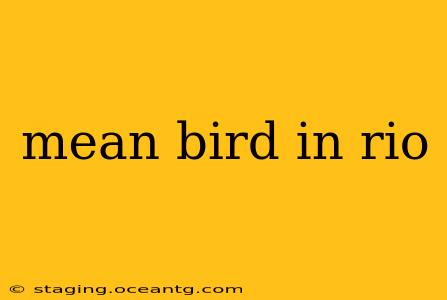Rio de Janeiro, a city renowned for its breathtaking beaches, vibrant culture, and iconic Christ the Redeemer statue, also harbors a diverse population of birds, some of which can exhibit surprisingly aggressive behavior. While many avian residents are charming and relatively docile, understanding the potential for aggressive encounters is crucial for both locals and tourists. This guide delves into the "mean birds" of Rio, exploring their behavior, habitats, and how to best navigate interactions with them.
What are some aggressive bird species found in Rio de Janeiro?
Several bird species in Rio can display aggressive behavior, particularly during breeding season or when defending their territory or young. Some of the most notable include:
-
Great Kiskadees ( Pitangus sulphuratus): These strikingly marked birds are common throughout Rio and are known for their bold and territorial nature. They're not afraid to attack perceived threats, including humans who venture too close to their nests. Their loud, distinctive call is often a warning sign.
-
Cattle Tyrants ( Machetornis rixosa): These smaller, but equally feisty birds are fiercely protective of their nests and territories. They might swoop down and aggressively chase away perceived intruders.
-
Various species of Hawks and Falcons: While not always overtly aggressive towards humans, these birds of prey can be quite territorial, especially during nesting season. It's best to keep a safe distance and avoid disturbing their nests.
Are there any specific areas in Rio where aggressive birds are more common?
Aggressive bird encounters are more likely in areas with dense vegetation, close proximity to nesting sites, or where birds have become habituated to human presence without fear of repercussions. Parks, wooded areas, and even some urban gardens can have higher concentrations of territorial birds. Be especially cautious near areas with known nesting sites, as birds will be most protective during breeding season.
What should I do if a bird attacks me in Rio?
If confronted by an aggressive bird, the best course of action is to remain calm and avoid any sudden movements. Slowly back away from the bird's territory, avoiding direct eye contact, as this can be perceived as a threat. Protecting your head and eyes is crucial. If the bird continues its attack, consider using a hat, umbrella, or jacket to shield yourself. Avoid hitting or harming the bird, as this can escalate the situation.
How can I avoid aggressive bird encounters in Rio?
Prevention is key. Here are some helpful tips:
- Be aware of your surroundings: Pay attention to your environment and watch out for signs of nesting birds, such as birds actively defending a specific area or the presence of nests.
- Keep a respectful distance: Avoid getting too close to birds, particularly during breeding season. Observe them from afar with binoculars or a camera with a good zoom lens.
- Avoid disturbing nests: Never attempt to approach or disturb a bird's nest.
- Don't feed the birds: Feeding birds can lead to them becoming less fearful of humans, potentially increasing aggressive interactions.
What are the dangers of bird attacks in Rio?
While most bird attacks won't cause serious injury, scratches and minor wounds are possible. In rare cases, larger birds or those carrying diseases could pose a greater risk. If you experience a significant injury or suspect infection, seek medical attention immediately.
Why are some birds in Rio more aggressive than others?
Several factors contribute to aggressive behavior in birds. Territoriality is a key driver, especially during breeding season when birds fiercely protect their nests and offspring. Habituation to human presence, where birds are not deterred by human activity, can also lead to increased aggression. Competition for resources, like food and nesting sites, can further fuel aggressive encounters.
By understanding the potential for aggressive bird encounters in Rio and following these preventative measures, you can enjoy the city's remarkable avian diversity while minimizing the risk of unpleasant interactions. Remember, respecting their space and observing them from a safe distance allows for a more peaceful and enriching experience for both you and the birds of Rio.
